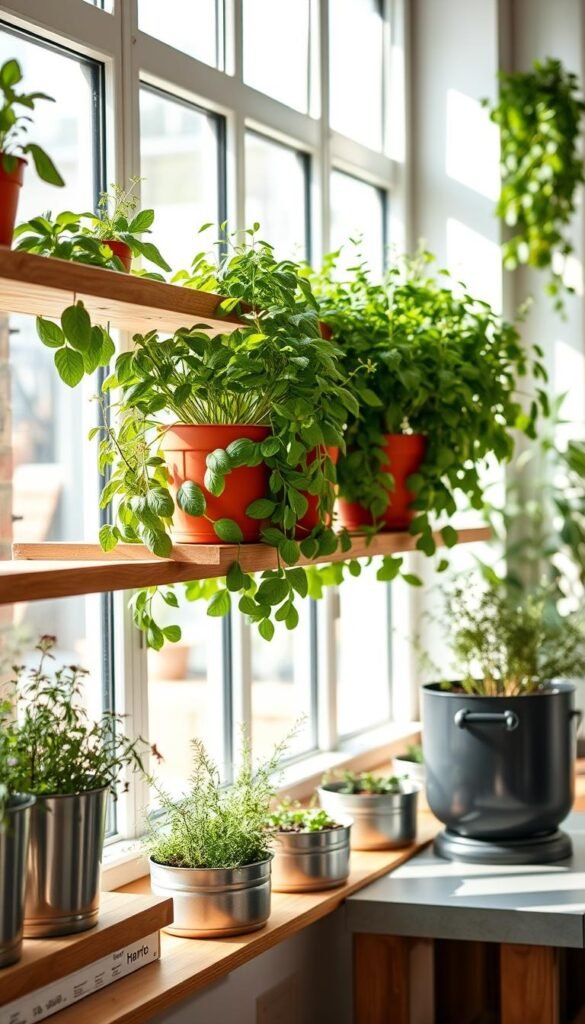Imagine reaching over while cooking to snip aromatic leaves straight from your countertop. Modern culinary enthusiasts are transforming their kitchens with vibrant greenery that serves both practical and decorative purposes. Even small spaces can host thriving plants that elevate meals and brighten your environment.
Growing edible plants indoors requires minimal effort yet delivers maximum rewards. You’ll enjoy 30% more antioxidants compared to store-bought dried versions while saving $1-$3 monthly per plant. With just 4-6 hours of sunlight daily, these living ingredients stay within arm’s reach year-round.
Many people love how these mini ecosystems deepen their connection to meal preparation. As you explore space-saving solutions, you’ll discover how simple containers can become stunning focal points. Your kitchen gains personality while your dishes burst with garden-fresh intensity.
This guide reveals how to select plants matching your taste preferences and lighting conditions. Whether you’re seasoning soups or crafting cocktails, you’ll learn to cultivate flavors that make every bite memorable.
Creating the Optimal Indoor Environment for Your Herbs
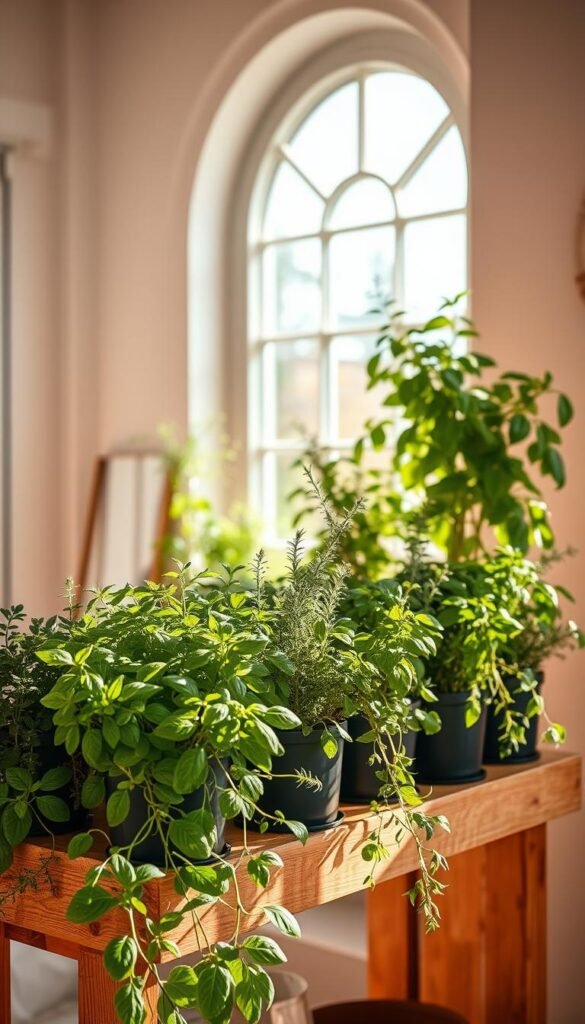
Your plants’ flavor potential depends on one key factor: light exposure. Just like chefs balance ingredients, you’ll need to balance natural and artificial illumination to keep leaves vibrant and aromatic.
Sunlight: Your Flavor Catalyst
Most leafy varieties thrive with 4-6 hours of direct sun daily. South or west-facing windows work best for rosemary, basil, and oregano, which crave intense rays. Notice stems stretching awkwardly or new growth appearing smaller? That’s your cue to move pots closer to sunlight.
East and north-facing spaces offer softer light perfect for mint and chives. These varieties actually develop better flavor in partial shade—their leaves stay tender without becoming bitter.
Boosting Light When Nature Falls Short
Winter months demand creativity. Full-spectrum LED panels positioned 6-12 inches above plants mimic natural conditions. “Think of grow lights as sun substitutes, not supplements,” advises urban gardening expert Jamie Chen. Set timers for 14-hour cycles to maintain steady growth patterns.
Choose adjustable fixtures with dimming options—they let you customize intensity as seasons change. This approach prevents scorching delicate leaves while ensuring consistent photosynthesis year-round.
Herb Garden Ideas Indoor: Best Varieties for Flavorful Home Cooking
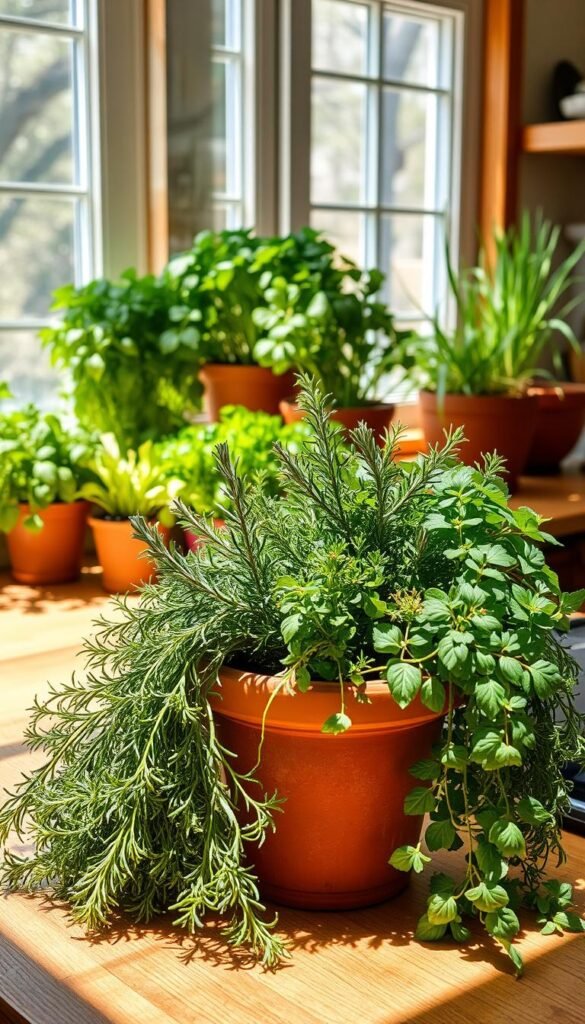
Your kitchen transforms into a flavor lab when stocked with fresh greens. Selecting the right plants turns everyday meals into culinary adventures. Let’s explore six aromatic options that thrive on countertops and bring restaurant-quality taste to your table.
Exploring Flavorful Herb Varieties for Your Kitchen
Basil reigns supreme for Italian-inspired creations. Its lush leaves elevate pasta sauces and caprese salads effortlessly. Frequent harvesting actually encourages bushier growth, so don’t hesitate to trim regularly.
Thyme’s earthy notes shine in roasted vegetables and soups. This compact grower fits perfectly on narrow windowsills. Unlike many leafy greens, it maintains robust flavor even when dried for long-term storage.
Parsley packs surprising nutritional power beyond its decorative role. Blend it into green juices or mix with garlic for chimichurri sauce. Curly and flat-leaf varieties both thrive indoors, offering texture contrast for your dishes.
Cilantro’s bright citrus punch revitalizes tacos and stir-fries. It prefers cooler spots away from intense afternoon sun. For continuous supply, sow new seeds every three weeks in shallow containers.
Oregano delivers Mediterranean warmth to pizzas and marinades. Place it near south-facing windows where it can soak up sunlight. Dry extra sprigs to create custom seasoning blends during winter months.
Rosemary’s pine-like aroma enhances roasted meats and focaccia. Its woody stems require infrequent watering—perfect for forgetful plant parents. Rotate pots weekly to ensure even growth toward light sources.
These kitchen staples form the backbone of global cuisines, from zesty Thai curries to hearty French stews. Pair them strategically to layer flavors in your signature recipes.
Choosing the Right Herbs for Your Kitchen
Transform your cooking space into a personalized spice haven with strategic plant choices. Three leafy stars rise above others for their versatility and low-maintenance nature—basil, thyme, and parsley form a flavor-packed foundation for countless recipes.
Spotlight on Basil, Thyme, and Parsley
Basil becomes your Italian cuisine ally, its sweet leaves perfect for pesto and Margherita pizzas. Pinch off flower buds to extend your harvest window. For thyme, snip sprigs into tomato-based dishes—its earthy notes intensify when cooked slowly.
| Plant | Daily Use Ideas | Growth Tip |
|---|---|---|
| Basil | Caprese salad, pasta sauces | Rotate pots weekly |
| Thyme | Roasted veggies, soups | Trim woody stems |
| Parsley | Green juices, garnishes | Keep soil moist |
Parsley’s vitamin C boost shines in detox drinks. “Heirloom seeds produce leaves with 40% more essential oils than commercial hybrids,” notes urban gardener Lisa Yang. Rotate plants every eight weeks to maintain peak flavor.
Avoiding Common Selection Mistakes
Many beginners choose exotic varieties they rarely use. Stick to what you actually cook with—if tacos dominate your menu, prioritize cilantro over lavender. Overcrowding causes three key issues:
- Reduced air circulation
- Uneven light distribution
- Higher pest risks
Group plants with similar thirst levels. Mediterranean natives like rosemary need less water than moisture-loving mint. Always check seed labels for non-GMO certification to ensure robust growth.
Step-by-Step Guide to Starting Your Indoor Herb Garden
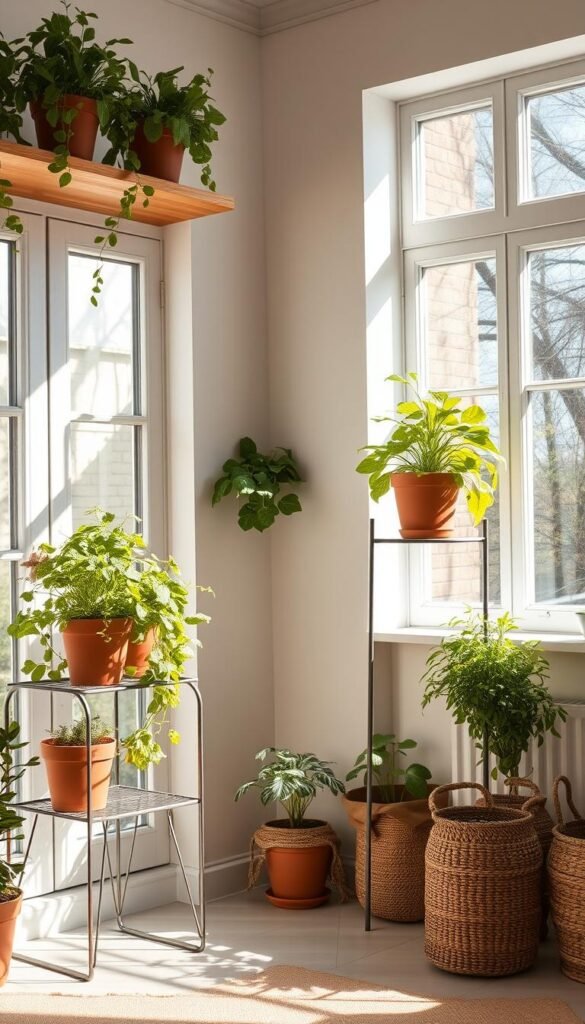
Roll up your sleeves—it’s time to turn your kitchen into a living pantry. With a few smart steps, you’ll nurture fresh flavors from tiny clippings to thriving plants. Let’s dive into the essentials for building a productive setup that fits any space.
Preparing Containers and High-Quality Soil
Your journey begins with choosing the right pots. Always pick ones with drainage holes—they’re non-negotiable for preventing soggy roots. Pair them with lightweight potting soil mixed with perlite or vermiculite for optimal airflow.
| Container Type | Best For | Drainage Tip |
|---|---|---|
| Terracotta | Mediterranean herbs | Add gravel layer |
| Plastic | Moisture-loving plants | Check hole size |
| Ceramic | Decorative displays | Use saucers |
Proper Watering and Care Practices
When propagating cuttings like thyme or spearmint, change water daily to avoid murky buildup. “Stagnant water is a root’s worst enemy,” notes hydroponics expert Mara Lin. If roots don’t appear within 10 days, start fresh—healthy clippings should show white tendrils by day 14.
Once roots fill their glass, transfer each cutting to its own pot. Crowding leads to competition—give plants personal space to stretch their roots. Water when the topsoil feels dry, but never let containers sit in standing water.
Installing and Adjusting Grow Lights for Your Setup
Not enough sunlight? Full-spectrum LEDs save the day. Position lights 8-12 inches above plants, using timers for 12-14 hour cycles. Rotate containers weekly so all sides receive equal exposure.
Adjust brightness as seasons change—dim during summer’s peak, intensify in winter. This step keeps flavors potent year-round. With these basics mastered, you’re ready to grow ingredients that transform ordinary meals into chef-worthy creations.
Innovative Indoor Herb Garden Setups and Displays
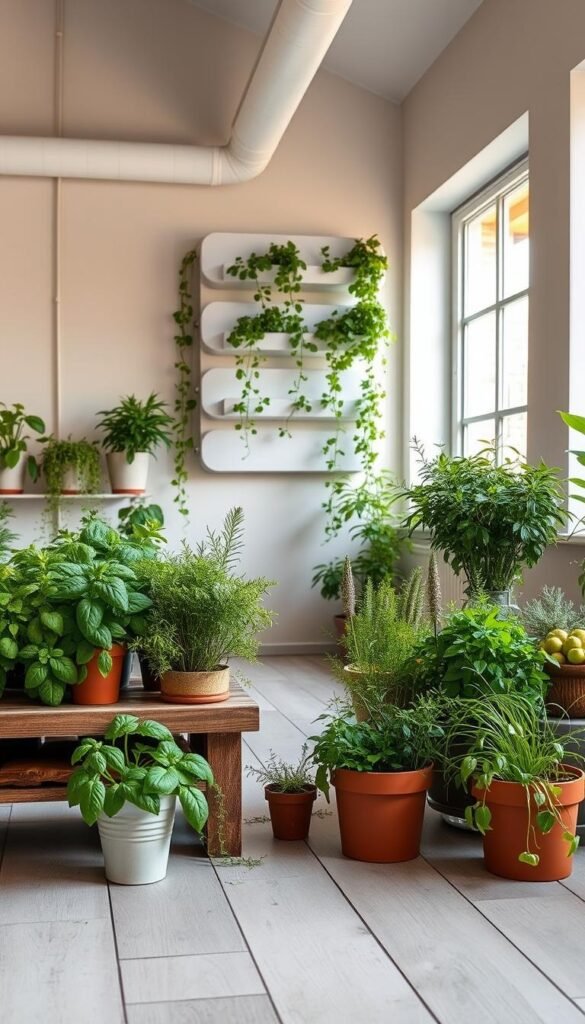
Unlock your kitchen’s hidden potential with clever growing solutions that blend form and function. Even compact areas can become lush greenery hubs when you think beyond traditional pots and shelves.
Window Sill Planters and Creative Shelving Ideas
Sunny ledges become flavor stations with tiered planters. Stackable terracotta containers or modular rail systems let you grow 6-8 varieties in a single window space. Pair with reflective surfaces like mirrored backsplashes to amplify natural light.
Hanging Herb Baskets and Vertical Arrangements
Macramé holders and ceiling-mounted racks turn unused airspace into aromatic displays. Try cascading mint or trailing rosemary in woven baskets. “Vertical setups reduce pest risks by 25% compared to ground-level plants,” notes urban farming consultant Elena Torres.
| Setup Type | Materials Needed | Best For |
|---|---|---|
| Magnetic Jars | Spice tins, magnets | Refrigerator gardens |
| Hydroponic Towers | PVC pipes, LED lights | High-tech kitchens |
| Repurposed Crates | Wooden boxes, liner | Rustic spaces |
DIY Urban Garden Projects for Small Spaces
Transform everyday items into unique containers. Old teacups become thyme planters, while shoe organizers host 12 herbs on a balcony door. Check out these indoor herb garden ideas for inspiration using recycled materials.
Wall-mounted gutter systems create instant growing channels. Space them 10 inches apart for proper airflow. For tech enthusiasts, countertop hydroponic units automate watering while adding modern flair to your cooking zone.
Maintaining and Transitioning Your Indoor Herbs Outdoors
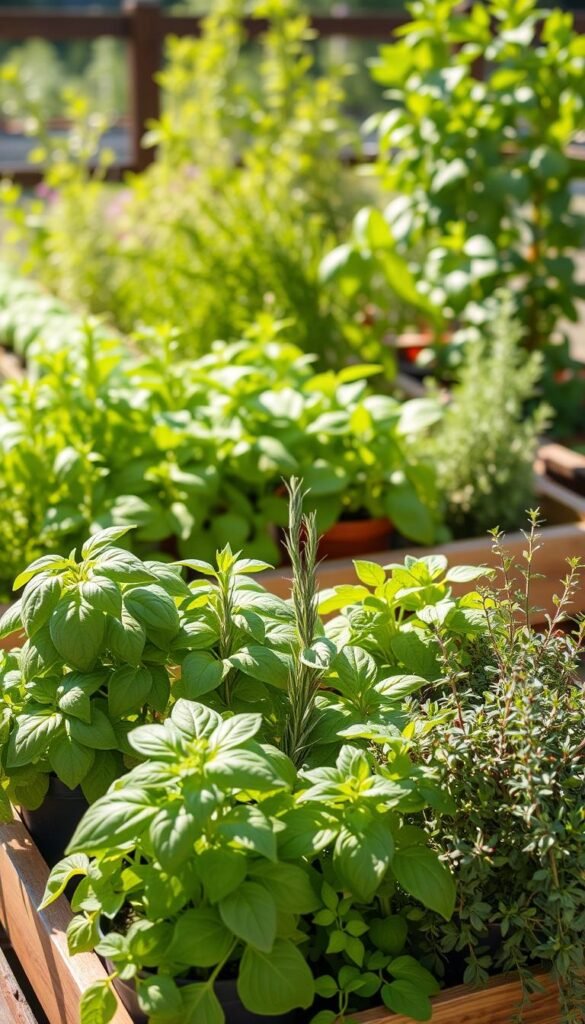
Moving your leafy companions outside requires careful planning. Sudden environmental changes can stress plants accustomed to controlled indoor conditions. Follow this proven method to help them thrive in their new open-air home.
Gradual Light Transition Techniques
Start with the shade phase. Place indoor plants under decks or north-facing walls for 3-5 days. This protects tender leaves from harsh rays while allowing adjustment to outdoor temperatures.
Progress to part-shade areas next. Choose spots receiving morning or late afternoon sun for limited periods. Watch for leaf discoloration—yellowing means too much light too soon.
| Phase | Duration | Light Exposure |
|---|---|---|
| Shade | 3-5 days | No direct sun |
| Part Shade | 3-5 days | 2 hours sun |
| Part Sun | 3-5 days | 4 hours sun |
| Full Sun | Permanent | 6+ hours sun |
Seasonal Care and Repotting Tips
Check roots annually during spring. If they circle the pot’s bottom, upgrade containers one size larger. Use fresh potting mix to replenish nutrients.
Water more frequently during summer transitions. Outdoor plants dry faster than their indoor counterparts. “Add a bit of mulch to retain moisture without drowning roots,” suggests horticulturist Mia Rodriguez.
Prune regularly to encourage bushier growth. Remove yellowing leaves promptly to prevent disease spread. With proper care, your herbs indoors will flourish outside all season.
Bringing Home the Freshness: Final Thoughts on Your Herb Journey
Your kitchen now holds more than pots and pans—it’s a living canvas where flavors grow. Cultivating an indoor herb garden bridges the gap between nature and nourishment, letting you pluck peppery basil or zesty oregano moments before they hit the skillet.
This green thumb adventure simplifies meal prep while deepening your connection to ingredients. You’ll spend less time shopping and more moments savoring dishes kissed by garden-fresh intensity. Even small spaces can thrive with smart setups—wall planters or compact hydroponic systems keep your herbs within reach.
As seasons change, so will your gardening rhythm. Make sure to rotate plants for even light exposure and refresh soil annually. Every snip strengthens your plants, creating a sustainable way to enhance daily meals. Let these fragrant companions remind you: great cooking starts with living ingredients that grow alongside your culinary life.

